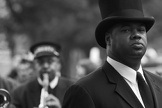The grief problem
 I’ve got an article in The Observer about the sad history of how psychologists have misunderstood grief and why it turns out to be much more individual than traditional theories have suggested.
I’ve got an article in The Observer about the sad history of how psychologists have misunderstood grief and why it turns out to be much more individual than traditional theories have suggested.
As well as the individual variations, it also riffs on the massive diversity of cultural grief and mourning practices.
At the beginning of Nicole Kidman’s 2008 film Australia, the audience is shown a warning. “Exercise caution when watching this film,” it says, “as it may contain images or voices of deceased persons.” The notice, perplexing for most viewers, was for the benefit of Aboriginal Australians, who may have a taboo against naming or encountering representations of the dead.
The taboo has spiritual roots relating to not disturbing spirits of the departed but anthropologist Katie Glaskin describes how the naming taboo “serves to make people ‘acutely aware’ of the person whose name is being avoided”. As a form of remembering through non-remembrance, it is a psychological mirror image of more familiar traditions where creating and cherishing a representation of the deceased is considered necessary for healthy mourning. This underlines the fact that mourning can take place in a radically different way, based on a thoroughly different understanding of death, highlighting how any claims to a universal “psychology of grief” pale in the face of human diversity.
The article has many more examples and we’re now at a stage where the idea that we go through specific ‘stages’ of grief is untenable scientifically – but lives on due to its powerful grip on society.
This is most worrying because it has been used to pathologise people who don’t seem to be grieving ‘appropriately’, branding them as ‘in denial’ when really they’re just dealing with things in their own way.
Link to article in The Observer.


Tom Stafford's Blog
- Tom Stafford's profile
- 13 followers



